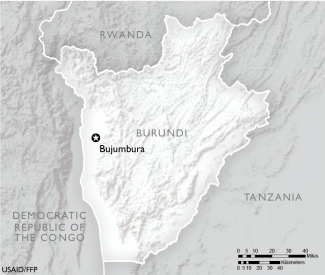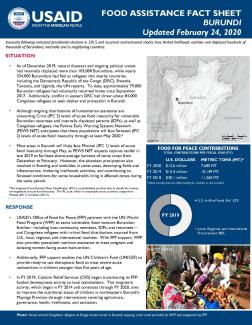February 24, 2020
Insecurity following contested presidential elections in 2015 and recurrent environmental shocks have limited livelihoods activities and displaced hundreds of thousands of Burundians, internally and to neighboring countries.
Situation
- As of December 2019, natural disasters and ongoing political unrest had internally displaced more than 103,000 Burundians, while nearly 334,000 Burundians had fled as refugees into nearby countries, including the Democratic Republic of the Congo (DRC), Rwanda, Tanzania, and Uganda, the UN reports. To date, approximately 79,000 Burundian refugees had voluntarily returned home since September 2017. Additionally, conflict in eastern DRC had driven about 84,000 Congolese refugees to seek shelter and protection in Burundi.
- Although ongoing distributions of humanitarian assistance are preventing Crisis (IPC 3) levels of acute food insecurity for vulnerable Burundian returnees and internally displaced persons (IDPs), as well as Congolese refugees, the Famine Early Warning Systems Network (FEWS NET) anticipates that these populations will face Stressed (IPC 2) levels of acute food insecurity through at least May 2020.*
- Most areas in Burundi will likely face Minimal (IPC 1) levels of acute food insecurity through May, as FEWS NET expects copious rainfall in late 2019 to facilitate above-average harvests of some crops from December to February. However, the abundant precipitation also resulted in flooding and landslides in some areas, destroying fields and infrastructure, hindering livelihoods activities, and contributing to Stressed conditions for some households living in affected zones during the same period.
* The Integrated Phase Classification (IPC) is a standardized tool that aims to classify the severity and magnitude of food insecurity. The IPC scale, which is comparable across countries, ranges from Minimal (IPC 1) to Famine (IPC 5).
Response
- USAID’s Office of Food for Peace (FFP) partners with the UN World Food Program (WFP) to assist vulnerable, food-insecure Burundian families—including host community members, IDPs, and returnees—and Congolese refugees with in-kind food distributions sourced from U.S., local, regional, and international markets. With FFP support, WFP also provides specialized nutrition assistance to treat pregnant and lactating women facing acute malnutrition.
- Additionally, FFP support enables the UN Children’s Fund (UNICEF) to provide ready-to-use therapeutic food to treat severe acute malnutrition in children younger than five years of age.
- In FY 2019, Catholic Relief Services (CRS) began transitioning its FFP-funded development activity to local stakeholders. This long-term activity, which began in FY 2014 and continues through FY 2020, aims to improve the nutritional status of children in northeastern Burundi’s Muyinga Province through interventions covering agriculture, governance, health, livelihoods, and sanitation.
Food for Peace Contributions
Total Contributions:
| U.S. Dollars | Metric Tons | |
|---|---|---|
| Fiscal Year 2020 | $12.6 million | 7,680 MT |
| Fiscal Year 2019 | $15.4 million | 10,149 MT |
| Fiscal Year 2018 | $30.1 million | 11,360 MT |


